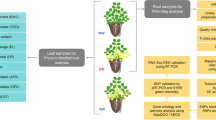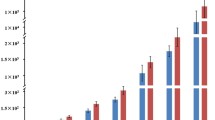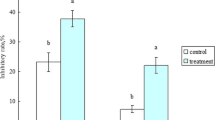Abstract
Allelopathy is the main cause of continuous cropping obstacles. Peanut wild species Arachis correntina (Burkart) Krapov. & W.C. Gregory is more resistant to continuous cropping obstacle than cultivated peanut, but its molecular mechanism in response to allelochemicals remains unknown. Benzoic acid (BA) and p-cumaric acid (PCA) are known allelochemical. To gain more insight into cellular response to BA and PCA, we applied high-throughput genetic sequencing to study the transcriptome changes of peanut cultivated variety Xiaobaisha and wild species A. correntina in the presence of 2 mM BA and PCA. The result showed that A. correntina resistance to BA and PCA stress was more weaker than Xiaobaisha. BA and PCA decreased significant shoot length and dry matter weight of A. correntina. Differentially expressed genes (DGEs) related to flavonoid biosynthesis, phenylpropanoid biosynthesis, plant–pathogen interaction and plant hormone signal transduction were transcribed less in A. correntina than Xiaobaisha under BA and PCA stress, including the less up-regulated genes involving in phenylpropane and flavonoid biosynthesis, detoxifying enzymes, Auxin responsive protein, WRKY family and Ef-hand, which might contribute to A. correntina’s weak resistance to BA and PCA stress. The results showed that the resistance to single allelopathic substance might not be the reason for A. correntina resistance to continuous cropping obstacle. In addition, DGEs of both A. correntina and Xiaobaisha were significantly enriched in the pathways associated with isoflavonoid biosynthesis and glutathione metabolism under BA and PCA stress. This was the first report on identification of DGEs under BA and PCA stress between peanut cultivated variety and wild species. The result would be great helpful to insight into the mechanisms of peanut response to allelochemicals stress.



Similar content being viewed by others
References
Abel S, Theologis A (1995) A polymorphic bipartite motif signals nuclear targeting of early auxin inducible proteins related to PSIAA4 from pea (Pisumsativum). Plant J 8:87–96
Aslam F, Khaliq A, Matloob A, Tanveer A, Hussain S, Zahir ZA (2017) Allelopathy in agro-ecosystems: a critical review of wheatalle- lopathy-concepts and implications. Chemoecology 27:1–24
Bertioli DJ, Cannon SB, Froenickel Froenicke L, Huang GD, Farmer AD, Cannon EKS, LiuX Gao DY, Clevenger J, Dash S, Ren LH, Moretzsohn MC, Shirasawa K, Huang W, Vidigal B, Abernathy B, Chu Y, Niederhuth CE, Umale P, Araújo ACG, Kozik A, Kim KD, Burow MD, Varshney RK, Wang XJ, Zhang XY, Barkley N, Guimarães PM, Isobe S, Guo BZ, Liao BS, Stalker HT, Schmitz RJ, Scheffler BE, Leal-Bertioli SCM, Xun X, Jackson SA, Michelmore R, Ozias-Akins P (2016) The genome sequences of Arachis duranensis and Arachis ipaensis, the diploid an cestors of cultivated peanut. NatureGenet 48(4):438–446
Bezuidenhout SR, Reinhardt CF, Whitwell I (2012) Cover crops of oats, stooling rye and three annual ryegrass cultivars influence maize and Cyperus esculentus growth. Weed Res 52(2):153–160
Blum U, Shafer SR, Lehman ME (1999) Evidence for inhibitory allelopathic interactions involving phenolic acids in field soils: concepts vs an experimental model. Critical Rev Plant Sci 18(5):673–693
Bogatek R, Gniazdowska A (2007) ROS and phytohormones in plant–plant allelopathic interaction. Plant Signal Behav 2:317–318
Bonawitz ND, Soltau WL, Blatchley MR, Powers BL, Hurlock AK, Seals LA, Weng JK, Stout J, Chapple C (2012) REF4 and RFR1, subunits of the transcriptional coregulatory complex mediator, are required for phenylpropanoid homeostasis in Arabidopsis. J Biol Chem 287(8):5434–5445
Bradshaw RA, Dennis EA (2010) Handbook of cell signaling, 2nd edn. Academic Press, Amsterdam. ISBN 9780123741455
Brunet S, Scheuer T, Klevit R, Catterall WA (2005) Modulation of CaV1.2 channels by Mg2 + acting at an EF-hand motif in the COOH-terminal domain. J Gen Physiol 126(4):311–323
Buchanan BB (2004) Plant biochemistry and molecular biology. Science Press, Beijing, pp 563–569
Cao G, Sofic E, Prior RL (1997) Antioxidant and prooxidant behavior of flavonoids: structure - activity relationship. Free Radic Biol Med 22(5):749–760
Chen SL, Zhou BL, Lin SS, Li XY, Xue L (2011) Accumulation of cinnamic acid and vanillin in eggplant root exudates and the relationship with continuous cropping obstacle. Afr J Biotechnol 10(14):2659–2665
Chin K, Moeder W, Yoshioka K (2009) Biological roles of cyclic nucleotide-gated ion channels in plants: what we know and don’t know about this 20 member ion channel family. Botany 87:668–677
Chujo T, Miyamoto K, Shimogawa T, Shimizu T, Otake Y, Yokotani N, Nishizawa Shibuya N, Nojiri H, Yamane H, Minami E, Okada K (2013) OsWRKY28, a PAMP-responsive transrepressor, negatively regulates innate immune responses in rice against rice blast fungus. Plant Mol Biol 82(1/2):23–37
Cramer GR, Urano K, Delrot S, Pezzotti M, Shinozaki K (2011) Effects of abiotic stress on plants: a systems biology perspective. BMC Plant Biol 11:163. https://doi.org/10.1186/1471-2229-11-163
Dai JC, Huang JG, Wang CL, Zhao KJ (2012) Pathogen conservation molecules and PAMP-triggered innate immunity in plants. Microbiol China 39(4):553–565 (in Chinese)
Dixon RA, Paiva NL (1995) Stress-induced phenylpropanoid metabolism. Plant Cell 7:1085–1097
Gao X, Cox KL, He P (2014) Functions of calcium-dependent protein kinases in plant innate immunity. Plants 3:160–176. https://doi.org/10.3390/plants3010160
He CN, Gao WW, Yang JX, Wu B, Zhang XS, Zhao YJ (2009) Identification of autotoxic compounds from fibrous roots of Panaxquinquefolium L. Plant Soil 318:63–72
Jones JDG, Dangl JL (2006) The plant immune system. Nature 444(7117):323–329
József R, Ana MB, Dénes S (2007) Resistance to Botrytis cinerea in sitiens, an abscisic acid-deficient tomato mutant, involves timely production of hydrogen peroxide and cell wall modifications in the epidermis. Plant Physiol 144(4):1863–1877
Kanehisa M, Araki M, Goto S, Hattori M, Hirakawa M, Itoh M, Katayama T, Kawashima S, Okuda S, Tokimatsu T, Yamanishi Y (2008) KEGG for linking genomes to life and the environment. Nucleic Acids Res 36:D480–D484
Kliebenstein DJ (2012) Plant defense compounds: systems approaches to metabolic analysis. Annu Rev Phytopathol 50(1):155–173
Kojetin DJ, Venters RA, Kordys DR, Thompson RJ, Kumar R, Cavanagh J (2006) Structure, binding interface and hydrophobic transitions of Ca2 + -loaded calbindin-D(28K). Nat Struct Mol Biol 13(7):641–647
Krapovickas A, Gregory WC, Simpson WCE (2007) Supplemento || taxonomy of the genus Arachis (Leguminosae). Bonplandia 16:7–205
Krauss G (2008) Biochemistry of signal transduction and regulation. Wiley, New York, p 15. ISBN 978-3527313976
Łaźniewska J, Macioszek VK, Kononowicz AK (2012) Plant–fungus interface: the role of surface structures in plant resistance and susceptibility to pathogenic fungi. Physiol Mol Plant Pathol 78(78):24–30
Leal-Bertioli SCM, Santos SP, Dantas KM, Inglis PW, Nielen S, Araujo ACG, Silva JP, Cavalcante U, Guimarães PM, Brasileiro ACM, Carrasquilla-Garcia N, Penmetsa RV, Cook D, Moretzsohn MC, Bertioli DJ (2015) Arachis batizocoi:a study of its relationship to cultivated peanut (A. hypogaea) and its potential for introgression of wild genes into the peanut crop using induced allotetraploids. Ann Bot 115(2):237–249
Leng N, Dawson JA, Thomson JA, Ruotti V, Rissman AI, Smits BMG, Haag JD, Gould MN, Stewart RM, Kendziorski C (2013) EBSeq: an empirical Bayes hierarchical model for inference in RNA-seq experiments. Bioinformatics 29(8):1035–1043
Li Y, Huang XF, Ding WL (2011) Autotoxicity of Panax ginseng rhizosphere and non-rhizosphere soil extracts on early seedlings growth and identification of chemicals. Allelopathy J 28(2):145–154
Li Z, Jiang LG, Tang RH, Xiong FQ, Tang XM, Jiang J, He LQ, Zhong RC, Han ZQ (2015) Identification and allelopathy of chemical compositions of peanut root exudates. J South China Agric Univ 36(5):48–53 (in Chinese)
Li Z, Jiang LG, Tang RH, Guo WF (2018) Effects of long-term continuous peanut cropping on dry matter weight of different peanut varieties, soil nutrient contents and enzyme activities. Soils 50(03):491–497 (in Chinese)
Liscm E, Reed JW (2002) Genetics of Aux/IAA and ARF action in plant growth and development. Plant Mol Biol 49(3–4):387–400
Livak KJ, Schmittgen TD (2001) Analysis of relative gene expression data using real-time quantitative PCR and the 2−ΔΔCT method. Methods 25:402–408
Lorenzo O, Nicolas C, Nicolas G, Rodriguez D (2002) Molecular cloning of a functional protein phosphatase 2C (Fs PP2C) with unusual features and synergistically up-regulated by ABA and calcium in dormant seeds of Fagus sylvatica. Physiol Plant 114:482–490
Luan S, Kudla J, Rodriguez-Concepcion M, Yalovsky S, Gruissem W (2002) Calmodulins and calcineurin B-like proteins: calcium sensors for specific signal response coupling in plants. Plant Cell 14:S389–S400
Mao X, Cai T, Olyarchuk JG, Wei L (2005) Automated genome annotation and pathway identification using the KEGG Orthology (KO) as a controlled vocabulary. Bioinformatics 21:3787–3793
Mao G, Meng X, Liu Y, Zheng Z, Chen Z, Zhang S (2011) Phosphorylation of a WRKY transcription factor by two pathogen-responsive MAPKs drives phytoalexin biosynthesis in Arabidopsis. Plant Cell 23(4):1639–1653
Meskiere I, Baudouin E, Schweighofer A, Liwosz A, Jonak C, Rod-riguez PL, Jelinek H, Hirt H (2003) Stress-induced protein phosphatase 2C is a negative regulator of a mitrogen-activated protein kinase. J Biol Chem 278:18945–18952
Neale AD, Biomstedt CK, Brorson P, Le TN, Guthridge K, Evans J, Gaff DF, Hamill JD (2000) The isolation of genes from the resurrection grass SporobolusStapfianus which are induced during severe drought stress. Plant Cell Environ 23:265–277
Qiu D, Xiao J, Ding X, Xiong M, Cai M, Cao Y, Li X, Xu C, Wang S (2007) OsWRKY13 mediates rice disease resistance by regulating defense-related genes in salicylate- and jasmonate-dependent signaling. Mol Plant Microbe Interactions 20(5):492–499
Ramakrishna A, Ravishankar GA (2011) Influence of abiotic stress signals on secondary metabolites in plants. Signal Behav 6(11):1720
Ramamoorthy R, Jiang SY, Kumar N, Venkatesh PN, Ramachandran S (2008) A comprehensive transcriptional profiling of the WRKY gene family in rice under various abiotic and phytohormone treatments. Plant Cell Physiol 49(6):865–879
Ratnaparkhe MB, Lee TH, Tan X, Wang X, Li J, Kim C, Rainville LK, Lemke C, Compton RO, Robertson J, Gallo M, Bertioli DJ, Paterson AH (2014) Comparative and evolutionary analysis of major peanut allergen gene families. Genome Biol Evol 6(9):2468–2488
Reed JW (2001) Roles and activities of Aux/IAA proteins in Arabidopsis. Trends Plant Sci 6:420–425
Rice EL (1984a) Allelopathy, 2nd edn. University of Oklahoma Press, Oklahoma, pp 1320–1344
Rice EL (1984b) Allelopathy, 2nd edn. University of Oklahoma Press, Oklahoma, pp 5–7
Rodriguez PL, Benning G, Grill E (1998) ABI2, a second protein phos-phatase 2C involved in ABA signal transduction in Arabidopsis thaliana. FEBS Lett 421:185–190
Saand MA, Xu YP, Li W, Wang JP, Cai XZ (2015) Cyclic nucleotide gated channel gene family in tomato: genome-wide identification and functional analyses in disease resistance. Front Plant Sci 6:303. https://doi.org/10.3389/fpls.2015.00303
Sanabria NM, Huang JC, Dubery IA (2010) Self/non-self perception in plants in innate immunity and defense. Self Nonself 1(1):40–54
SchweighoferA Hirt H, Meskiene I (2004) Plant PP2C phosphatases: emerging functions in stress signaling. Trends Plant Sci 19:236–243
Sène M, Doré T, Pellissier F (2000) Effect of phenolic acids in soil under and between rows of a prior sorghum (sorghum bicolor) crop on germination, emergence, and seedling growth of peanut (Arachis hypogea). J Chem Ecol 26(3):625–637
Sheen J (1996) Ca2+-dependent protein kinases and stress signal transduction in plants. Science 274:1089–1092
Sheng L (2003) Protein phosphatases in plants. Annu Rev Plant Biol 54:63–92
Singh HP, Batish DR, Kohli RK (1999) Autotoxicity: concept, organisms, and ecological significance. Crit Rev Plant Sci 18:757–772
Stone JM, Walker JC (1995) Plant protein kinase families and signal transduction. Plant Physiol 108:451–457
Tahtiharju S, Palva T (2001) Antisense inhibition of protein phosphatase 2C accelerates cold acclimation in Arabidopsis thaliana. Plant J 6:461–470
Thiruvengadam M, Baskar V, Kim SH, Chung IM (2016) Effects of abscisic acid, jasmonic acid and salicylic acid on the content of phytochemicals and their gene expression profiles and biological activity in turnip (Brassica rapa ssp. rapa). Plant Growth Regul 80:377–390
Tiwari SB, Wang XJ, Hagen G, Guilfoyle TJ (2001) Aux/IAA proteins are active repressors and their stability and activity are modulated by auxin. Plant Cell 1(3):2809–2822
Uddin MR, Li X, Won OJ, Park SU, Pyon JY (2012) Herbicidal activity of phenolic compounds from hairy root cultures of Fagopyrumtataricum. Weed Res 52(1):25–33
Van Loon LC, Rep M, Pieterse CMJ (2006) Significance of inducible defense-related proteins in infected plants. Annu Rev Phytopathol 44:135–162
Vogt T (2010) Phenylpropanoid biosynthesis. Mol Plant 3:2–20
Vranová E, Langebartels C, Van MM, Inzé D, van Camp W (2000) Oxidative stress, heat shock and drought differentially affect expres- sion of a tobacco protein phosphatase 2C. J Exp Bot 51:1763–1764
Worley CK, Zenser N, Ramos J, Rouse D, Leyser O, Theologis A, Callis J (2000) Degradation of Aux/IAA proteins is essential for normal auxin signalling. Plant J 21:553–562
Yechun W, Steven C, Oliver Y (2011) Metabolic engineering of flavonoids in plants and microorganisms. Appl Microbiol Biotechnol 91(4):949–956
Young MD, Wakefield MJ, Smyth GK, Oshlack A (2010) Gene ontology analysis for RNA-seq: accounting for selection bias. Genome Biol. https://doi.org/10.1186/gb-2010-11-2-r14
Acknowledgements
This study was funded by the Science Development Foundation of Guangxi Academy of Agricultural Sciences (Nos. 2018JZ35, 2017JZ15), and the National Natural Science Foundation of China (Nos. 31460115, 31660087, 31660428).
Author information
Authors and Affiliations
Corresponding author
Ethics declarations
Conflict of interest
The authors declare that they have no conflict of interest.
Human and animals rights
This article does not contain any studies with human participants or animals performed by any of the authors.
Informed consent
Informed consent was obtained from all individual participants included in the study.
Additional information
Publisher's Note
Springer Nature remains neutral with regard to jurisdictional claims in published maps and institutional affiliations.
Electronic supplementary material
Below is the link to the electronic supplementary material.
Rights and permissions
About this article
Cite this article
Li, Z., Xiong, F., Guo, W. et al. The root transcriptome analyses of peanut wild species Arachis correntina (Burkart) Krapov. & W.C. Gregory and cultivated variety Xiaobaisha in response to benzoic acid and p-cumaric acid stress. Genet Resour Crop Evol 67, 9–20 (2020). https://doi.org/10.1007/s10722-019-00859-6
Received:
Accepted:
Published:
Issue Date:
DOI: https://doi.org/10.1007/s10722-019-00859-6




